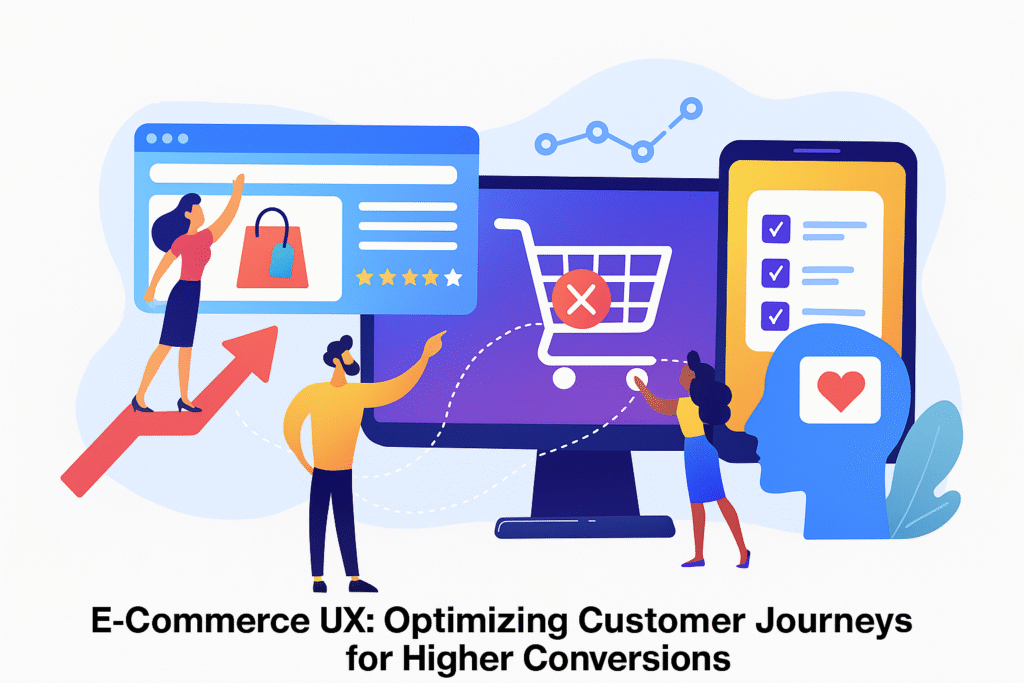In today’s competitive digital marketplace, having an e-commerce store is not enough. What truly differentiates successful online businesses from the rest is User Experience (UX) — the ease, flow, and satisfaction a customer feels while navigating through your website.
Optimizing UX doesn’t just enhance aesthetics; it directly impacts conversions, revenue, and brand loyalty. A clunky checkout process, confusing product pages, or poor mobile experience can quickly lead to cart abandonment. On the other hand, a seamless, intuitive, and personalized journey keeps customers engaged and drives them to complete purchases.
This blog explores best practices and strategies to improve E-Commerce UX, focusing on product pages, cart abandonment solutions, personalization, and mobile checkout optimization.
Why UX Matters in E-Commerce
User experience is at the heart of every customer journey. According to studies, 88% of online shoppers say they wouldn’t return to a site after a bad user experience. That means UX is not just a design concern — it’s a business necessity.
A strong UX ensures that:
- Visitors find what they’re looking for quickly.
- The buying process is smooth and hassle-free.
- Customers feel confident and secure when purchasing.
- The brand creates trust and encourages repeat shopping.
Product Page Best Practices
Product pages are the heart of any e-commerce website. They act as the decision-making point where customers evaluate whether to buy.
Key elements of optimized product pages:
- High-Quality Visuals: Multiple images, zoom features, and videos help customers understand the product better.
- Clear CTAs (Call-to-Actions): Phrases like “Add to Cart” or “Buy Now” should be visible and compelling.
- Concise Product Descriptions: Informative yet scannable descriptions improve customer confidence.
- Customer Reviews & Ratings: Social proof influences decision-making significantly.
- Trust Badges: Displaying secure payment logos and return policies instills confidence.
By streamlining product pages, you reduce friction and move customers closer to conversion.
Reducing Cart Abandonment
Cart abandonment is one of the biggest challenges for e-commerce businesses. Research shows that around 70% of online shopping carts are abandoned.
Solutions to reduce cart abandonment:
- Simplify Checkout: Limit form fields and allow guest checkouts.
- Transparent Pricing: Avoid hidden costs that frustrate customers.
- Multiple Payment Options: Offer credit cards, wallets, UPI, and EMI.
- Exit-Intent Popups: Provide discounts or reminders to bring customers back.
- Abandoned Cart Emails: Personalized reminders can recover lost sales.
Optimizing the checkout journey is crucial to turning interest into revenue.
Personalization in E-Commerce UX
Today’s customers expect experiences tailored to their needs. Personalization not only enhances engagement but also drives conversions.
Ways to personalize e-commerce UX:
- Product Recommendations: Based on browsing history or previous purchases.
- Dynamic Content: Show different offers for first-time visitors vs. loyal customers.
- Location-Based Suggestions: Tailor products, currency, and shipping options to customer regions.
- Personalized Emails: Curated product suggestions increase repeat purchases.
Personalization creates a sense of relevance and builds long-term relationships.
Seamless Mobile Checkout Experiences
With more than 60% of e-commerce traffic coming from mobile devices, mobile UX can make or break conversions.
Best practices for mobile optimization:
- Responsive Design: Ensure smooth browsing across devices.
- One-Click Checkout: Speed is essential for mobile buyers.
- Digital Wallets: Integrating Google Pay, Apple Pay, and PayPal makes payments seamless.
- Auto-Fill Forms: Reduce effort with saved shipping and payment details.
- Fast Loading Speed: Even a few seconds of delay can lead to drop-offs.
A mobile-first approach ensures you capture the largest share of your audience effectively.
Measuring and Improving UX
Optimizing UX is not a one-time effort. Regular analysis and improvements ensure long-term success.
Tools & Metrics to Track UX Success:
- Google Analytics: Track bounce rates, conversions, and user flows.
- Heatmaps & Session Recordings: Understand customer behavior on pages.
- A/B Testing: Compare different layouts, CTAs, and checkout flows.
- Customer Feedback: Surveys and reviews provide direct insights.
By consistently testing and refining, you ensure your e-commerce platform evolves with customer expectations.
Final Thoughts
Optimizing E-Commerce UX is the key to higher conversions, customer satisfaction, and long-term loyalty. From designing effective product pages to reducing cart abandonment, personalizing experiences, and ensuring mobile-friendly checkouts, every touchpoint matters.
A seamless customer journey doesn’t just sell a product — it builds trust, brand value, and repeat business.
📢 Final Call to Action
Want to transform your e-commerce platform into a conversion powerhouse? At Seventy9Media, we specialize in designing intuitive, conversion-focused online stores. Whether you’re aiming to reduce cart abandonment, personalize shopping, or improve mobile UX, we can help.
🚀 Let’s optimize your customer journeys today. Contact Seventy9Media

